The contemporary turntables are highly versatile and require minimal adjustments and extensive preparation. Many have digital outputs to connect to a PC or digital audio gear. DJs frequently use turntables to produce distinct sounds by manipulating the playback speeds and scratching the vinyl records.
The first thing to determine is the purpose of buying a turntable (e.g. listening to the vinyl collection, transmitting the latter into the digital file, enhancing the DJ deck). Specific features like number and type of connections, platter material, adjustable speed and so on will arise. Besides, you’ll have to deal with the general parameters as well:
- Preamp. It can be built-in or a turntable might require an external preamp.
- Setup. The options range from fully automatic mode to the manual-only operation.
- Size and weight. Take into account both the available space and the requirement for portability.
- Dust cover. A plus for any setup.
We have compiled a list of the best turntables under $1000 based on such parameters as sound quality, easiness of use, and solidity of the build. Check it now to spot your vinyl setup!
Turntable under $1000 Reviews
Pro-Ject Debut Carbon EVO
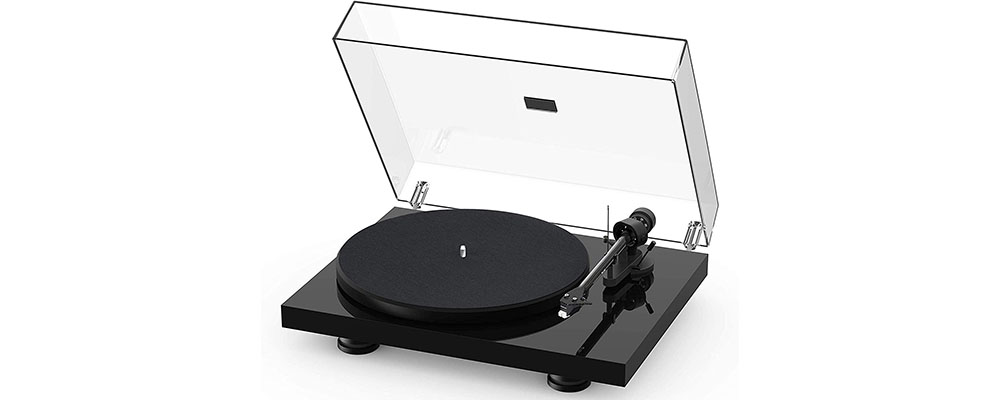
I had the pleasure of testing the Pro-Ject Debut Carbon EVO, a direct-drive turntable that boasts high-quality components and impressive performance. This turntable offers exceptional value for its price point, making it a top contender for those seeking the best turntable under 1000 dollars.
The Pro-Ject comes with a pre-mounted Ortofon 2M Red moving magnet cartridge, which is known for its excellent tracking ability and detailed sound. The turntable’s platter is made of a heavy, high-density MDF material, which helps reduce vibrations and provides a stable playback surface. The tonearm is also made of carbon fiber, which is both lightweight and rigid, resulting in improved tracking and reduced resonance.
In terms of dimensions, the turntable measures 16.34 inches x 4.65 inches x 12.60 inches and weighs 14.33 lbs. The motor is a high-torque direct drive design, which provides smooth and consistent playback speed. The turntable has two playback speeds, 33 1/3 and 45 RPM, which can be easily selected using the switch on the turntable’s top panel.
This professional turntable with direct drive also features a range of controls, including adjustable tracking force and anti-skate, which allow for precise cartridge setup and improved sound quality. The turntable’s output sockets include RCA phono cable, which ensures compatibility with most audio systems.
Overall, the Pro-Ject Debut Carbon EVO is a highly capable and professional turntable that offers exceptional value for its price. Its high-quality components, direct drive motor, and precise controls make it an ideal choice for audiophiles and music enthusiasts alike who look for the best turntable for under 1000 dollars.
Pros
- The turntable’s motor is isolated from the main plinth, which helps reduce vibrations and improve overall sound quality.
- The turntable’s dust cover is removable, allowing for easy access to the turntable and cartridge for maintenance and upgrades.
- The turntable’s stylish and minimalist design makes it a great addition to any home audio setup.
Cons
- The turntable’s direct-drive motor may produce more audible motor noise than belt-driven turntables, which may be a concern for some users.
- The turntable’s pre-mounted cartridge may not be suitable for all music genres and listening preferences, and may require upgrading for optimal sound quality.
- The turntable does not come with a built-in phono preamp, which may require an additional purchase for users who do not have a phono preamp in their audio system.
Pro-Ject T1 BT
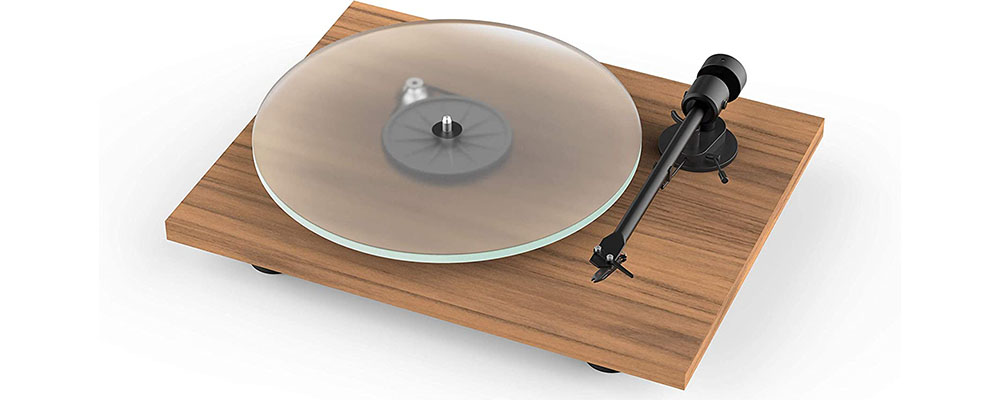
As a professional tester, I had the opportunity to test the Pro-Ject T1 BT turntable, a high-quality turntable that combines exceptional sound quality with modern features such as built-in Bluetooth connectivity. This turntable is one of the best turntables under 1000 dollars on the market today.
The Pro-Ject T1 BT features a heavy, high-density MDF platter, which provides a stable playback surface and reduces vibrations. The tonearm is made of a lightweight, high-rigidity aluminum material, which helps reduce resonance and improve tracking. The turntable measures 16.33 inches x 4.65 inches x 12.60 inches and weighs 8.82 lbs.
The Pro-Ject T1 BT is powered by a quiet, high-torque motor, which provides consistent playback speed and reduces motor noise. The turntable offers two playback speeds, 33 1/3 and 45 RPM, and comes with a pre-mounted Ortofon OM 5E MM cartridge, which is known for its detailed sound and excellent tracking ability.
In terms of controls, the Pro-Ject T1 BT features adjustable tracking force and anti-skate controls, which allow for precise cartridge setup and improved sound quality. The turntable also includes a built-in preamp, which allows for direct connection to audio systems without a separate phono preamp.
One of the standout features of the Pro-Ject T1 BT is its built-in wireless audio transmitter, which allows for easy Bluetooth connectivity to compatible audio devices such as speakers and headphones. This feature provides flexibility and convenience for users who want to enjoy high-quality audio without the need for wires or cables.
Overall, the Pro-Ject T1 BT is a top-performing turntable that offers a great combination of classic sound quality and modern features. That is why we included it in our best turntable under $1000 shortlist. Its high-quality components, built-in preamp, and wireless audio transmitter make it a great choice for music enthusiasts who want a hassle-free audio experience.
Pros
- The turntable’s Bluetooth connectivity allows for easy wireless streaming of high-quality audio to compatible speakers and headphones.
- The turntable’s heavy platter and high-quality tonearm work together to provide excellent sound quality and tracking accuracy, resulting in a great listening experience.
- The included cables are of high quality and low resistance gauge.
Cons
- While the plexiglass top of the turntable adds a touch of elegance to its overall design, users should be aware that it may scratch easily with frequent use or mishandling.
- It does not have an automatic lift function for the tonearm at the end of a record.
Rega Planar 2 RB220
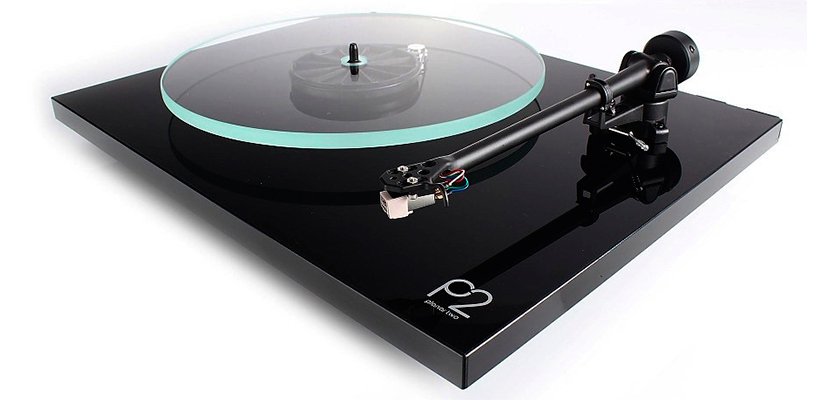
This turntable is an excellent demonstration of how time-tested technology can be improved with the latest advancements. It features the same typical for Rega high quality of material and assembly, together with the characteristic energetic sound, while being simple in operation and setup. There is definitely more than one reason to call it the best turntable under $1000. However, switching the speed manually on this turntable can be time-consuming and require effort, while some of its competitor models have an automatic in-house switching mechanism.
The construction is made to ensure high stability of tonearm and therefore, the fluent distortion-free sound. It features all of the recent developments including the automatic anti-skating mechanism, aluminum arm with built-in shell, regulated counterweight. Additionally, the vertical bearings made of lightweight but stiff plastic ensure the rigidity of tonearm position and prevent any skips or pops during playback.
The motor is a synchronous type that emits next to no noise. It works confidently on both 33-1/3 RPM and 45 RPM speeds and has a passive cooling system. The plinth is solid and reduces motor vibration efficiently. The turntable boasts a gloss acrylic finish that, combined with the Optiwhite platter, exudes a sophisticated and luxurious appearance.
Still, what makes this model hit the spot among the best turntables under $1000 is its rhythmic and accurate sound with typical for Rega Planar impressive bass. The soundstage is open and dense, with highly precise imaging and rich detail. The sound produced by the turntable exhibits a rich tonality and a melodious quality, with notably detailed vocal representation.
Pros
- Deep lows with rich texture and high dynamics.
- ⅓-inch platter bearing ensures steady rotation without vibration.
- Highly stable rubber feet.
Cons
- The absence of markings on the counterweight can make it somewhat challenging to adjust the tracking force.
- No preamp.
Pioneer PLX1000
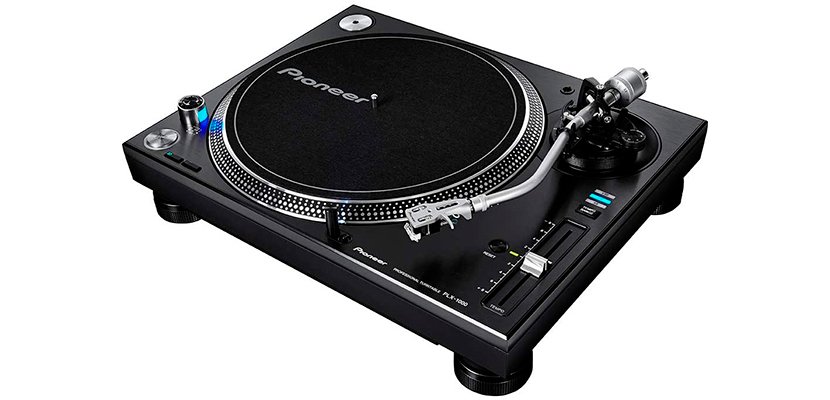
The solid design of this direct-drive turntable stands behind its high-quality noise isolation and pure precise sound. It’s definitely a great option among turntables under $1000 while the price is quite high considering that the cartridge and stylus aren’t supplied. However, the overall dynamics and distortionless audio stay there even with the basic cartridge.
The plinth is heavy die-cast, with the addition of resin and other dampening materials. The platter has a substantial weight and stability and feels textured, making it an excellent choice for DJs who want to scratch or speed up/brake the records. The platter rotation is rock steady and doesn’t feature any wobbling or uneven issues during the speed selection.The turntable’s motor has high torque and operates silently, while its pitch range enables users to increase the speed by up to 50%.
The Pioneer PLX1000 features the standard DJ table design with a bit of a stylish touch. The controls feel solid and shaped differently (represented by buttons, knobs, dials), which helps not mix anything up. The LED lighting for the controls and platter is bright enough to be visible but not distracting, allowing users to keep an eye on the essential controls without being distracted by unnecessary ones.
The sound of this potentially the best record player under 1000 dollars impresses with high clarity and sensitivity throughout the frequency range. It emits well-balanced rhythmic audio with good detailing and highly accurate mids and lows. Though treble can reach extreme limits, it might feature occasional cut-offs while the middle line and lows are solid and punchy.
Pros
- Sensitive power switch requires very little effort to turn on/off.
- The tonearm has rubber insulation for dampening the external impact.
- Detachable RCA cords with gold-plated connection ports.
Cons
- Interference might appear near powered monitors.
- Arm lift drops heavily.
Video Pioneer PLX1000
Audio-Technica AT-LP7
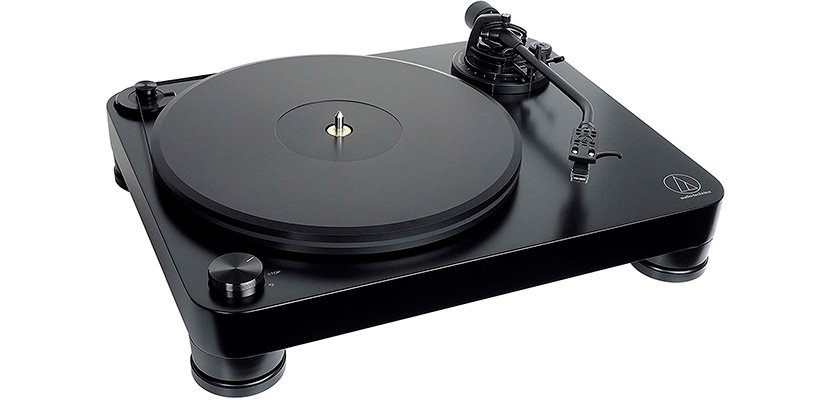
The high price of this turntable and its manual operation doesn’t prevent it from being ranged as the best turntable under $1000 in the dedicated charts. Its most highlighted advantages are compatibility with both moving magnet and moving coil cartridges, and sensor-equipped motor providing steady rotation speed in various conditions.
The turntable looks stylish, with its all-black matte components and the exquisite J-shaped tonearm.The connections are conveniently located on the bottom panel and are easily accessible. The preamp is built-in enabling quick connection to the speakers, AV receivers and amplifiers without phono inputs. Additionally, the turntable features a separate switch for preamp activation or deactivation, allowing users to bypass the preamp if necessary.
The tonearm features a rigid construction with the removable headshell and easy cartridge swapping mechanism. It has a gimbal suspension resulting in the fluent and precise tracking, with no external pops. The Audio-Technica dual magnet cartridge enables high precision of the sound and even frequency response.
The AT-LP7’s sound quality is detailed and rich, allowing users to vividly picture all the instruments and voices and accurately and confidently image them. The mids are filled with nuance and fluent, the high is airy and feature if a touch of brightness. The low end is solid, with sharply drawn yet powerful beats and deep growling lows. Overall dense backstage and sharp detailing, together with the punchy attack let rate this model as potentially the best audiophile turntable under $1000.
Pros
- The turntable’s sound is both highly accurate and powerful, delivering exceptional rhythmic and dynamic performance.
- ⅘-inch polymer platter dampens the vibration while keeping the constant rotation speed.
- Regulated feet let set the height to the user’s preference.
Cons
- With preamp activated, the highs become a bit muffled and cut off.
- Non-hinged dust cover.
U-Turn Audio
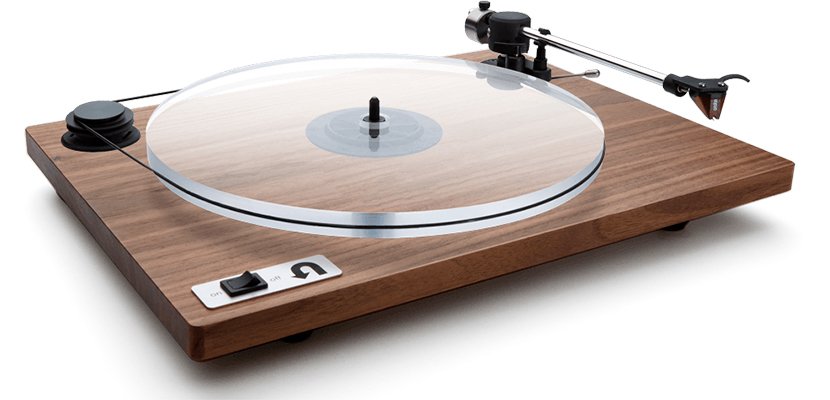
Precision-made with built-in preamp and external belt system, this turntable is easy to set up and operate while the sound features high clarity and authenticity. Considering the middle-range price, this model could easily be marked as the best turntable under $1000. However, as a fully manual turntable with limited functions, this model may not appeal to those who prefer more advanced features and automation.
The plinth is made of solid hardwood with a smooth finish. The platter is acrylic and features high stability. It damps next to all the vibration enabling crystal clear sound and distortion-free performance throughout the volume and frequency range.
The turntable’s straight tonearm is reinforced with additional bearings, providing stable tracking and allowing for easy positioning in a matter of seconds. It features the Ortofon 2M cartridge that brings the expansive soundstage with a ton of detail. The audio is highly dynamic, with rich ample mids and lows and open transparent highs. The turntable’s frequency response is consistent across the entire playback spectrum, including at extreme frequencies such as super-highs and bottom lows. The sound is rich and natural, detailed and almost colorless. The audio has a good balance while each instrument and voice line is distinct and individual.
The U-Turn Audio turntable boasts a powerful motor that offers two rotation speeds (33-1/3 RPM and 45 RPM) and operates with minimal noise. Great sound and simple design make the U-Turn Audio a great option among the best turntables under $1000.
Pros
- External belt positioning lets change playback speed within seconds.
- The tonearm is equipped with the internal anti-skating mechanism.
- Cue lever lets position the arm on a disc quickly and easily.
Cons
- The three-feet base isn’t too steady — the ‘“table” can be tipped over if moved.
- The dust cover may be unstable when in the open position.
Video U-Turn Audio
Reloop AMS-RP-8000
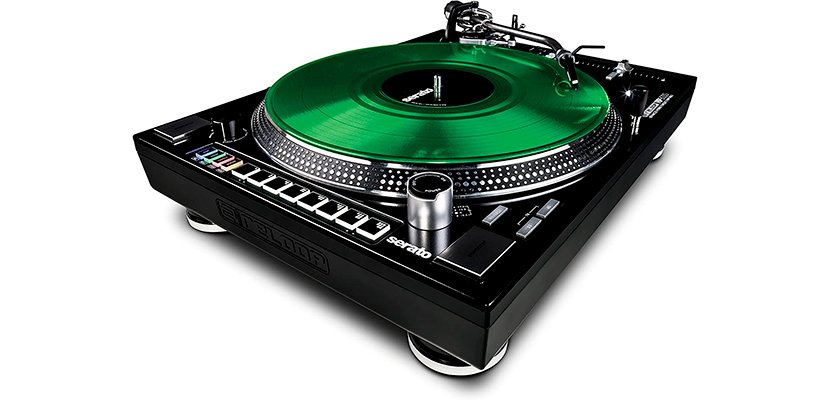
This is not just a good turntable under $1000 but a fully functional hybrid of the turntable with the MIDI controller. Such combination is handy for DJ tasks; yet, the vibration caused by the additional elements and fast hitting on buttons requires the enhanced isolation of both plinth and tonearm and completely flat and sturdy surface.
The MIDI controller provides eight buttons that can be grouped to the user’s liking into 2×4 pads. It can be used for sampling, mixing, looping, etc. and allows for individual control mapping. The turntable’s USB port enables users to store or retrieve samples to/from a flash drive or computer, allowing for full MIDI controller functionality.
The base is sturdy while being made of plastic with metallic coverage on top and damps the noise and vibration efficiently. The platter rotates steadily and doesn’t flutter with the change of speed, which is performed via the rubber buttons for 33-⅓ and 45 RPM speed (pressed together, these buttons allow reaching 78 RPM).
The turntable’s motor is fast and low-noise, offering the flexibility of low- and high-torque operation. The pitch can range from 8% to 50%, and the fader is very sensitive and intuitive, with LED lighting around the active zone.
The sound of the Reloop AMS-RP-8000 features a lot of dynamics and energy, deep well-drawn bass and wide mids and highs. This potentially the best automatic turntable under 1000 dollars delivers particularly good detailing in the mids and lows, although the depth of high-pitched voices and instruments may be slightly compromised.
Pros
- Trax encoder lets browse the playlist and enables easy loading of tracks.
- Digital display lets control the torque and pitch range.
- Connection ports are recessed providing good support even for heavy cables.
Cons
- Mixer pads are lined in one row and aren’t lighted.
- The power and encoder knobs are positioned too closely to the platter.
Buyer’s Guide
What technical functions you need to consider choosing a turntable?
When shopping for a turntable, you might notice the specifications of vinyl players differ from those outlined for digital devices. The turntable ‘reads’ the sound wave from the grooves on the vinyl disc rotating on a platter. To “pick” the sound, the stylus should be very thin to enter the groove. The turntable transmits analog data to the cartridge, which converts it into an electrical impulse and sends it to the preamp for further amplification through the speakers. Particulars of this process make the features that should be considered when buying a turntable.
Equipment compatibility
In order to get a quality sound, a single turntable isn’t enough. The minimal audiophile setup consists of:
- turntable;
- preamp;
- powered speakers.
It can be further developed by introducing an amplifier between the preamp and speakers. The more components the system feature, the more there is room for an upgrade. However, complex setups with multiple connections can result in quality loss and added interference, which can be a concern.
Before purchasing a turntable, think of the audio gear you already have. For example, if you already have a quality preamp or an AV receiver with the phono input, your range of choice gets wider including both tables with preamp and without it. The technical specifications matter as well. The equipment should be compatible according to voltage, impedance, and other parameters. The premium turntable might sound weak with the mediocre speakers while the basic vinyl player can be impressive with a quality preamp / amp.
Belt drive or direct drive
The type of motor connection with the platter is a key factor in determining the range of turntable functions and specifications. There are several types of turntables, including:
- Belt-driven. The motor is separated from the platter and sends the rotation power via the belt. In this construction, the signal-to-noise ratio is quite high. However, these turntables cannot be used for scratching or other DJ techniques.
- Direct-drive. The motor is beneath the platter and lets spin it at a high speed, as well as apply scratching. Still, this construction requires high-quality isolation and presumes considerable weight of a deck.
Manual or automatic
This parameter concerns the tonearm operation. In manual mode, the user must manually direct the tonearm onto the record and place it onto the groove. When the record is over, the user should return the tonearm back to its idle position.
In the automatic mode, the tonearm movement (and in some cases, setup as well) is performed automatically, without user’s intrusion. It’s quite convenient, especially for the beginners in the vinyl listening. The turntable is generally a “plug-n-play” type. No precise calculation of the weight, downforce, etc. is needed.
However, such technology requires additional cables and electric schemes, which can affect the clarity of the signal. As vinyl discs are appreciated first of all due to the depth of the audio and rich detail, this parameter can become a deal-breaker for the audiophile. Most modern high-end turntables are of the manual type.
Pitch control
The pitch control panel lets change the speed of the disc rotation. It can be slower or faster than the initial set speed. Usually, the speed can be varied in the range of 8% – 16% of the basic parameter. Meanwhile, some DJ turntables reach 50% pitch.
Speed
Vinyl discs differ by size and spinning speed. The latter is measured in revolutions per minute (RPM) and stands for the number of full spins the disc makes within 60 seconds.
Vinyl discs can be of following types:
- 33-⅓ RPM — also called LPs (“long play”). The largest (10, 12, or even 16 inches in diameter) vinyl discs that contain about 22 minutes of sound on each side.
- 45 RPM — only 7 inches in diameter, these discs can record only about 5 minutes per each side. Due to the smaller size, they need an adaptor to be played on the 33-11/3-bound turntable.
- 78 RPM — different in diameter, they can house 4 minutes max on each side.
Many modern turntables are capable of playing both 33-⅓ and 45 RPM records, while some models can also play 78 RPM records. The speed can be switched between 33-⅓ and 45 RPM through a button or via belt adjustment.
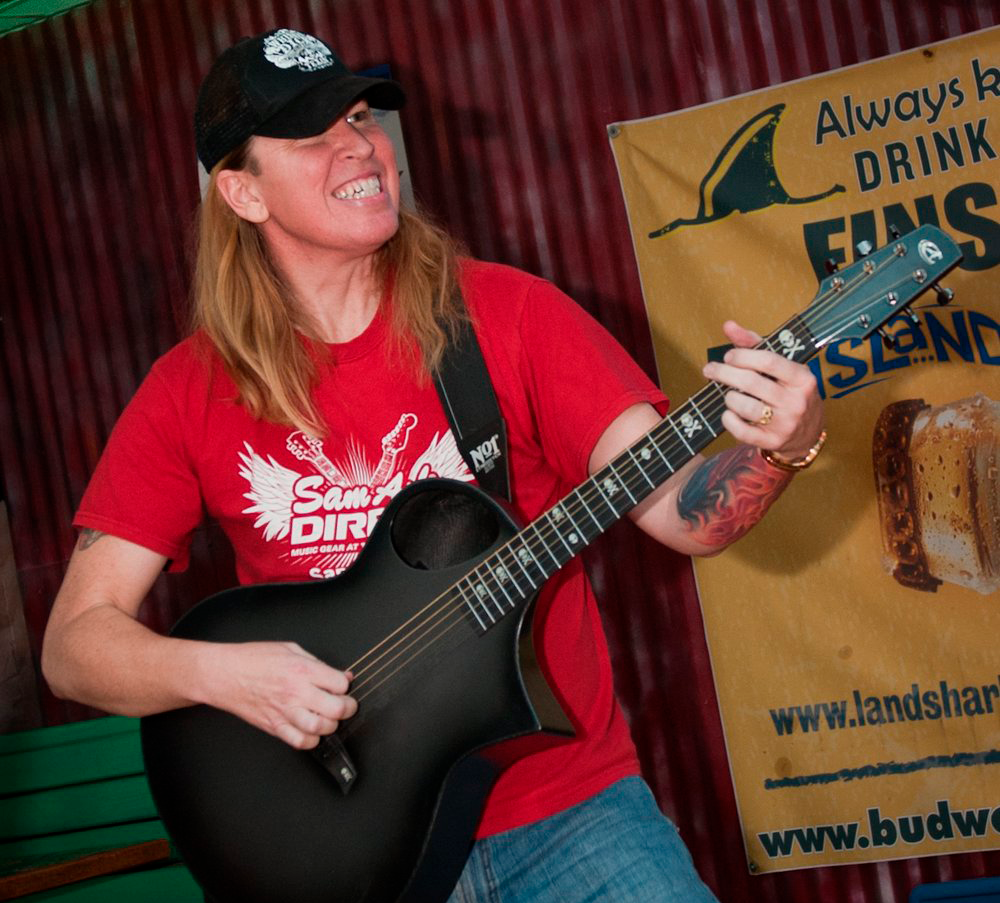
Hi everyone! I’m Thomas Moody, also known as Guitarzan.

